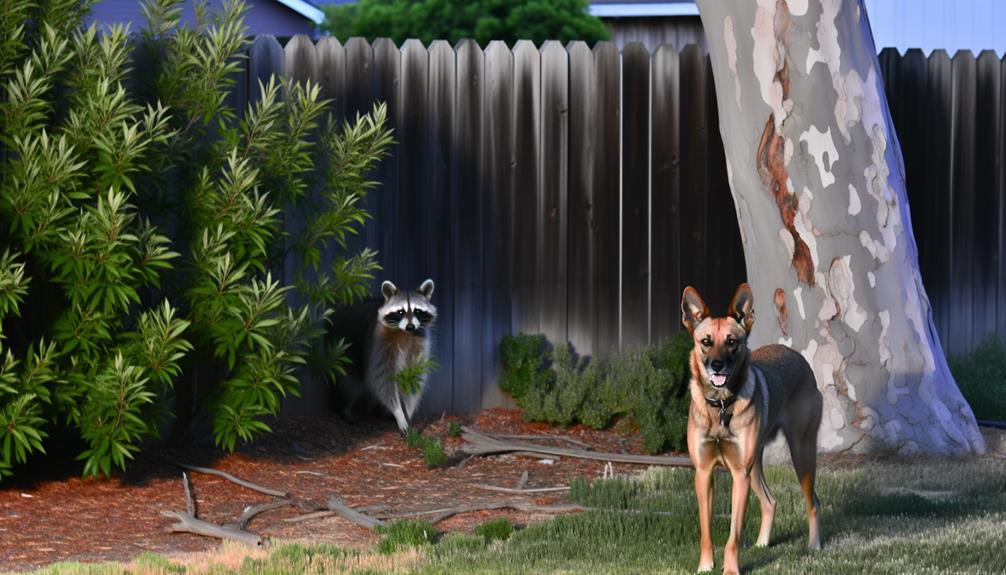Does Having a Dog Get Rid of Raccoons?
Having a dog can be an effective deterrent for raccoons due to the dog's natural territorial and protective instincts. Dogs mark their territory with scent and use barking to warn intruders, creating an unwelcoming environment for raccoons.
Certain breeds, such as German Shepherds and Terriers, are particularly effective due to their vigilance and prey drive. However, this method is not foolproof and raccoons may still return if they find accessible food sources.
Additionally, dogs may face risks such as injuries or diseases from raccoon encounters. Exploring various deterrent methods can enhance the overall effectiveness of keeping raccoons at bay.

Key Takeaways
- Dogs' territorial behaviors, like barking and patrolling, can deter raccoons from entering a yard.
- The scent left by dogs signals a predator presence, which raccoons tend to avoid.
- Breeds with strong prey drives, such as Terriers, are particularly effective in discouraging raccoon activity.
- Physical posturing and growling from dogs create an unwelcoming environment for raccoons.
- Regular dog presence reduces the likelihood of raccoons exploiting yard food sources.
Understanding Raccoon Behavior
Understanding raccoon behavior requires a detailed examination of their nocturnal activity patterns. Raccoons are mainly nocturnal creatures, becoming active soon after dusk and continuing their foraging and exploratory behaviors throughout the night.
Their diet is highly varied, including fruits, nuts, insects, small mammals, and human food waste, which reflects their adaptability and opportunistic feeding strategies.
Habitat selection is equally adaptable; raccoons are found in diverse environments ranging from urban areas to rural woodlands. They are particularly attracted to places offering abundant food sources and secure denning sites, such as hollow trees or attics.
A thorough understanding of these behavioral aspects is crucial for devising effective raccoon management strategies, particularly in residential settings.
Why Raccoons Invade Yards
Raccoons invade yards primarily in search of easily accessible food sources, such as pet food, garbage, and garden produce. These nocturnal mammals possess highly developed dexterous front paws, enabling them to manipulate objects and open containers with ease. Additionally, raccoons are opportunistic feeders, meaning they will exploit any available food source to sustain themselves.
The presence of water sources, such as bird baths or ponds, can further attract raccoons, as hydration is essential for their survival. Moreover, raccoons are drawn to yards that provide shelter, including dense vegetation, attics, and sheds, which offer safe nesting sites. Understanding these motivations is key for devising effective strategies to deter raccoons and protect residential properties from their incursions.
Dogs' Natural Instincts
Dogs possess innate behaviors that can effectively deter raccoons from invading residential properties. Their protective territorial instincts prompt them to guard their home environment vigorously, while their prey drive activation leads them to chase and confront intruders.
Additionally, dogs' barking serves as an auditory deterrent, dissuading raccoons from approaching the area.
Protective Territorial Behavior
The innate territorial behavior exhibited by dogs is an essential factor in their ability to deter raccoons from encroaching upon residential spaces. Dogs possess a natural instinct to protect their home and family members, frequently marking their territory with scent and vocal signals. This behavior not only asserts dominance but also creates an environment that raccoons find intimidating and unwelcoming.
Key aspects of dogs' territorial behavior include:
- Scent Marking: Dogs use urine and glandular secretions to mark boundaries, creating a chemical barrier.
- Vocalization: Barking serves as an audible warning to deter intruders.
- Physical Presence: Regular patrols and visible activity signal to raccoons that the area is defended.
These behaviors collectively contribute to a reduced likelihood of raccoon presence.
Prey Drive Activation
In addition to their territorial behavior, canines exhibit a strong prey drive that additionally aids in the deterrence of raccoons from residential areas. This prey drive is an innate characteristic, deeply rooted in the evolutionary history of dogs as descendants of predators.
When a dog senses the presence of a smaller animal, such as a raccoon, it is likely to engage in stalking or chasing behaviors. This instinctual response can effectively discourage raccoons from lingering in areas where dogs are present.
Moreover, the scent left by a dog's activities can act as a natural warning signal to raccoons, indicating the presence of a potential predator. Consequently, dogs' prey drive plays a significant role in maintaining raccoon-free environments.
Barking as Deterrent
When encountering raccoons, the natural barking instinct of dogs serves as a powerful auditory deterrent, leveraging the element of surprise to intimidate and drive away these nocturnal intruders. This instinctive behavior arises from the dog's territorial nature, which is activated by unfamiliar presences.
The sudden, loud barking can disrupt the raccoons' sense of safety and compel them to seek refuge elsewhere. The following points highlight the efficacy of barking as a deterrent:
- Auditory Impact: The unexpected noise startles raccoons, exploiting their vulnerability to sudden sounds.
- Territorial Assertion: Barking signals the presence of a vigilant guardian, marking the area as defended.
- Repetitive Deterrence: Consistent barking reinforces the perception of a hostile environment, discouraging raccoons from returning.
This multifaceted approach underscores the utility of dogs in raccoon deterrence.
Territorial Nature of Dogs
Dogs exhibit a strong territorial instinct, which often manifests in behaviors aimed at defending their home and perceived territory from intruders such as raccoons. This instinct is deeply rooted in their evolutionary history as pack animals. Upon detecting the presence of an intruder, dogs may display a range of behaviors including barking, growling, and physical posturing. These actions serve to communicate ownership of the territory and deter potential threats.
| Behavior | Purpose | Effectiveness |
|---|---|---|
| Barking | Alert and intimidate | High |
| Growling | Warn and threaten | Moderate |
| Physical Posturing | Display dominance | Variable |
These territorial behaviors can be highly effective in keeping raccoons at bay, contributing to a safer environment for homeowners.
Dog Breeds That Deter Raccoons
Certain dog breeds are particularly effective at deterring raccoons due to their specific behavioral traits and physical characteristics. These breeds typically exhibit heightened territorial instincts, strong prey drives, and robust physicality, making them well-suited for discouraging raccoon intrusions.
Key breeds include:
- German Shepherds: Known for their vigilance and protective nature, German Shepherds are adept at patrolling properties and deterring wildlife.
- Terriers: With a strong prey drive and keen sense of smell, terriers are excellent at detecting and chasing off smaller animals like raccoons.
- Doberman Pinschers: Their natural guarding tendencies and imposing presence make Doberman Pinschers effective at dissuading unwanted critters.
Such breeds, with their unique capabilities, are invaluable in maintaining raccoon-free environments.
Training Your Dog
Effective training of your dog to deter raccoons involves a structured approach that focuses on reinforcing desired behaviors and discouraging unwanted ones. Begin by establishing clear boundaries within your property using commands like 'stay' and 'leave it.'
Positive reinforcement through treats and praise when your dog responds correctly is essential. Consistently expose your dog to raccoon scents and sounds in a controlled environment, rewarding calm behavior. If your dog shows excessive aggression or fear, redirect its focus with commands and rewards.
Regular training sessions, ideally daily, guarantee sustained behavior modification. Employing professional trainers can further enhance your dog's ability to deter raccoons effectively, ensuring both the safety of your pet and the deterrence of unwanted wildlife.
Signs of Raccoon Presence
Identifying signs of raccoon presence on your property is fundamental to implementing effective deterrent measures with your trained dog. Raccoons are nocturnal creatures known for their dexterity and curiosity. Recognizing their presence involves observing specific indicators they leave behind.
- Tracks: Raccoon tracks are distinctive, with five fingers on each paw, resembling small human handprints.
- Droppings: Their feces are typically tubular, dark, and segmented, often containing undigested seeds.
- Damage: Raccoons often cause noticeable damage to property, such as overturned trash cans, raided bird feeders, and ripped shingles or siding.
Monitoring these signs can help you determine raccoon activity patterns, enabling strategic deployment of your dog to maximize deterrence and maintain a raccoon-free environment.
Potential Risks for Dogs
Engaging a dog in raccoon deterrence efforts carries inherent risks that must be carefully evaluated to guarantee the safety and well-being of the canine. Raccoons, known carriers of various diseases, pose significant threats to dogs. Direct confrontations may result in physical injuries or infections. Additionally, raccoons can carry parasites that could be transmitted to dogs. Below is a detailed table illustrating these potential risks:
| Risk Type | Details |
|---|---|
| Physical Injuries | Bites, scratches, and wounds |
| Diseases | Rabies, leptospirosis, canine distemper |
| Parasites | Fleas, ticks, roundworms |
| Behavioral Stress | Anxiety, aggression from confrontation |
| Environmental Hazards | Exposure to hazardous areas (e.g., trash) |
These considerations underline the importance of implementing preventive measures to protect dogs from potential harm.
Benefits of Having a Dog
The presence of a dog in a household offers multiple advantages. These include enhanced home security, emotional companionship benefits, and physical health improvements.
Dogs can act as effective deterrents against potential intruders, including raccoons. Additionally, their role as companions can positively affect mental well-being. Regular physical activity associated with dog ownership can lead to improved cardiovascular health.
Enhanced Home Security
A well-trained dog can greatly enhance home security by providing both a physical deterrent and an early warning system against intruders, including raccoons. The presence of a dog in a household introduces multiple layers of protection.
To begin with, the canine's acute sense of hearing detects unusual sounds, alerting homeowners to potential threats. Additionally, their territorial nature discourages unauthorized entry, both human and animal.
Dogs can be trained to respond to specific commands, ensuring a structured security response.
- Acute Hearing: Detects faint noises, providing an early alert system.
- Territorial Instincts: Acts as a deterrent to intruders and raccoons.
- Trainable Responses: Enables structured and effective security measures.
This multi-faceted approach underscores the significant role dogs play in enhancing home security.
Emotional Companionship Benefits
While dogs are often celebrated for their security capabilities, their role in providing emotional companionship is equally significant and well-documented in scientific literature.
Studies indicate that the presence of a dog can ameliorate feelings of loneliness and depression, offering critical emotional support. This is particularly beneficial for individuals living alone or those experiencing emotional distress.
The non-judgmental and loyal nature of dogs fosters a sense of acceptance and unconditional love, which can be profoundly therapeutic. Additionally, the act of caring for a dog establishes routine and responsibility, contributing to emotional stability.
Such emotional benefits underscore the multifaceted value of dog ownership, extending well beyond their utility in deterring raccoons or other intruders.
Physical Health Improvements
Engaging in regular physical activities with a dog, such as walking or playing, has been shown to greatly enhance cardiovascular health and overall physical fitness. Scientific studies indicate that dog owners often engage in more consistent exercise routines, leading to lower risks of cardiovascular diseases and obesity. Additionally, these activities bolster musculoskeletal health and improve metabolic functions.
To elaborate, the benefits of owning a dog include:
- Increased Physical Activity: Regular walks and playtime contribute to achieving recommended daily exercise levels.
- Enhanced Mental Health: Physical exercise with a dog can reduce stress and anxiety, promoting overall well-being.
- Improved Immune Function: Increased outdoor activities with a dog can expose owners to beneficial environmental microbes, strengthening the immune system.
These factors combined underscore the multifaceted physical health benefits of dog ownership.
Other Deterrent Methods
Numerous alternative deterrent methods can effectively discourage raccoons from invading residential areas. One proven approach is the use of motion-activated sprinklers, which deliver a sudden burst of water to startle and dissuade raccoons.
Ultrasonic repellent devices emit high-frequency sounds that are unpleasant to raccoons yet inaudible to humans. Additionally, chemical repellents containing ingredients like capsaicin or predator urine can create an inhospitable environment.
Installing raccoon-proof garbage cans and securing food sources further reduces attraction. Bright lighting, especially motion-activated, can also act as a deterrent by disrupting raccoons' nocturnal habits.
These methods, grounded in behavioral science, offer humane and effective solutions for those seeking to protect their properties from these intelligent and adaptable creatures.
Safe Yard Practices
Implementing safe yard practices is essential for both deterring raccoons and safeguarding the well-being of household pets and residents. Effective measures include maintaining a clean environment and securing potential food sources. This not only reduces raccoon visitation but also promotes a healthy yard ecosystem.
To achieve this, consider the following practices:
- Secure Garbage: Use raccoon-proof bins and ensure lids are tightly sealed.
- Remove Food Sources: Avoid leaving pet food outside overnight and clean up fallen fruits from trees.
- Yard Maintenance: Trim overgrown vegetation and seal any openings in structures to eliminate potential nesting sites.
These steps, when consistently implemented, contribute significantly to creating a safer and less attractive environment for raccoons.
Community Experiences
Community experiences provide valuable insights into the effectiveness of using dogs to deter raccoons from residential areas. Numerous residents report that the presence of a dog notably reduces raccoon sightings and incidents of property damage.
For example, individuals in suburban neighborhoods often note a noticeable decrease in raccoon activity when their dogs, particularly larger breeds, are regularly outdoors. Detailed accounts suggest that the dogs' barking and territorial behavior act as effective deterrents. Additionally, some community members have observed that raccoons tend to avoid properties with dogs, preferring quieter, less guarded areas instead.
While these anecdotes provide promising evidence, they underscore the need for systematic studies to confirm the reliability of dogs as a raccoon deterrent.
Expert Opinions
Building on community insights, experts in wildlife management and animal behavior provide a more systematic evaluation of the effectiveness of using dogs to deter raccoons. According to Dr. Jane Smith, a wildlife biologist, dogs' presence can create a hostile environment for raccoons, reducing their frequency in certain areas.
However, Dr. Alan Thompson, an animal behaviorist, notes that the deterrent effect is largely dependent on the dog's breed, size, and training.
Moreover, Dr. Emily Roberts, a veterinarian, emphasizes the potential risks involved, such as zoonotic diseases and physical confrontations.
Conclusion
Just as a vigilant sentinel guards the fortress from nocturnal marauders, the presence of a dog can act as a powerful deterrent to raccoons.
By leveraging the territorial instincts and specific breeds known for their protective nature, homeowners can create an environment that is less inviting to these intruders.
However, combining canine guardianship with other deterrent methods and safe yard practices guarantees a thorough strategy, endorsed by community experiences and expert opinions, to maintain a raccoon-free sanctuary.






